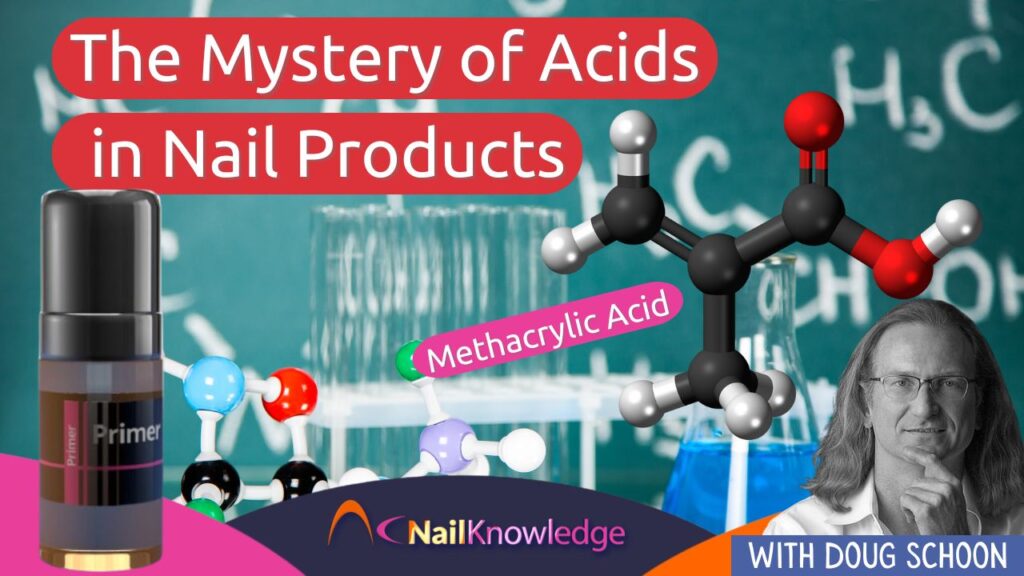When it comes to nail care, understanding the role of acids in various nail products is crucial for achieving healthy and beautiful nails. In this guide, we’ll explore the world of acids in nail products, debunk common myths, and provide essential safety tips for users.
Descifrando el papel de los ácidos en los productos para las uñas: Separar la realidad de la ficción
There’s a lot of confusion about pH and its effect on the nail plate. Acids are often misunderstood.
Acids play a significant role in nail products, but their presence often raises concerns among consumers. Let’s start by breaking down the basics of acids and their function in nail care.
Tipos de ácidos en los productos para uñas: Orgánicos frente a inorgánicos
Acids can be categorized into two main types: organic and inorganic. Organic acids, containing carbon, not “certified organic”, are commonly found in nail products and are generally safer for use. On the other hand, inorganic acids, while less common in nail care, require more cautious handling due to their potentially corrosive nature.
For example, vinegar is a harmless weak organic acid, while sulfuric acid is a dangerous strong inorganic acid. Just because something is acid doesn’t mean it is harmful, so don’t let the word scare you. Note: Strong inorganic acids are not used in nail products.
Acabar con los mitos: Desmontando ideas falsas
Some acids and bases (alkaline) are corrosive to human skin and eyes, posing a risk to soft tissues. Bearing this in mind, let’s debunk a common myth about nail primers that contain acids, like methacrylic acid. Many believe that methacrylic acid eats holes in the nail plate to improve adhesion, but this is a misconception. Methacrylic acid is actually a weak organic acid that does not dissolve the nail plate. To demonstrate, I’ve soaked nail clippings in 100% methacrylic acid primers for months without any damage. Unlike strong inorganic acids, which can harm the nail plate, methacrylic acid is safe for such uses in the professional nail industry. This highlights the significant differences among types of acids, showing they are not the same.
La seguridad ante todo: Navegar por el consumo de ácido
While some acids are corrosive to skin and eyes, methacrylic acid is particularly potent. If using primers containing this acid, it’s crucial to avoid contact with skin and eyes. The nail plate, a highly cross-linked structure, resists damage from methacrylic acid. However, skin and eyes are vulnerable and can rapidly suffer damage upon contact. Should any contact with this type of primer occur on the skin, wash it off immediately with soap and water and keep rinsing for at least five minutes to prevent worsening corrosion. Eye contact is more severe; rinse the eye and seek medical attention right away.
Importancia del equipo de protección: Protección frente a posibles peligros
Por seguridad, utilice siempre guantes y gafas de protección cuando utilice imprimaciones de ácido metacrílico. Recuerde, menos es más con las imprimaciones. Aplicar demasiada puede hacer que se filtre en las paredes laterales, causando dolor y posibles quemaduras en la piel. Además, el uso excesivo de imprimación disminuye su eficacia. Para obtener resultados óptimos, aplique sólo una capa fina sobre las placas de uñas limpias y secas.
Creo que es interesante señalar que el pH del ácido metacrílico está entre 1-2 y este tipo de ácido no daña la placa de la uña, por lo que el pH no es un buen indicador de daño de la uña, cuando se trata de productos para las uñas.
Menos es más: Aplicar los ácidos con moderación
Applying nail products containing acids in moderation is key to preventing overexposure and potential skin irritation. By using these products sparingly and following recommended guidelines, users can achieve optimal results without compromising nail health.
Conocimiento para los usuarios
Demystifying acids in nail products is the first step towards empowering users to make informed choices about their nail care routine. By understanding the role of acids, debunking myths, and prioritizing safety, individuals can enjoy healthy and beautiful nails without fear or uncertainty.


